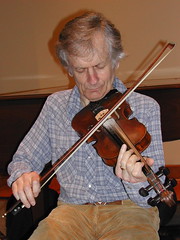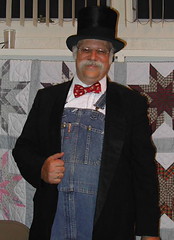Mike Seeger was in residence at the University of Kentucky to participate in a doctoral musicology seminar "The History of Old Time Music" directed by Ron Pen. With the generous support of the Appalachian Center, Mike led three afternoon seminars, met individually with students, performed at the "Woodsongs Radio Hour" live broadcast at the Kentucky Theater and at the WUKY "Curtains at Eight" radio program, presented a public concert at the UK Student Center Theater, and gave a lecture/performance at the Gallery of the John Jacob Niles Center for American Music. There were also various other social and musical events, such as the opening music night at the Gaines Center for the Humanities, dinner at the Gaines Feast held in a vintage tobacco barn at Equus Run Vineyards, and a potluck supper at Ron Pen's Clark County home.
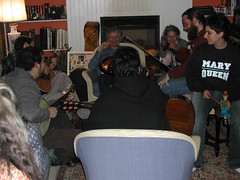
Here are some reactions by students in the seminar:
[Matt]
Famous folk singer and instrumentalist Mike Seeger, despite being in his seventies, continues to do it all when it comes to old time music. Whether watching him perform at a small concert, observing him play at a live radio show, hearing him lecture in a graduate musicology seminar, or listening to his folk music experiences in a one-on-one meeting, Mike Seeger effectively informs younger generations of the history and current trends of old time music. My first exposure to the autoharp and gourd banjo, for example, came on the first night of Mike's residency as he and his wife, Alexia, sang a soothing number about an anonymous "worried man" at an evening live radio show on the Woodsongs Radio Network. Although Seeger mentioned that night that he did not listen to the radio much as a child, his practice of performing on live radio shows and producing CDs testify to his acceptance of this medium. Several class discussions on Regionalism and Revivalism of old time music demonstrated his authority on the subject (especially since he embodied a large part of old time music revivalism as a member of the New Lost City Ramblers). His expert knowledge of the banjo served me well in selecting a topic for a final presentation assignment. Seeger's residency concluded as he displayed exceptional talent on the guitar and Jew's harp in a closing concert where [insert the name of the tune about Jonah and the whale here] was played.
[Paige] I was especially impressed by his honesty regarding his roots and how his personal experiences shaped his concept of authenticity. Mike gave us a sense of revivalism as a legitimate movement within and continuation of the Old Time idiom, rather than a pseudo-Old Time subgenre of the Folk movement, as some of us were inclined to consider it. Despite being himself an "outsider" of sorts, Mike is fiercely protective of Old Time and wary of the effect commercialization has had and may continue to have on the genre. Obviously, he has wrestled with the idea of propagation versus exploitation, and seems to be very aware of the thin line that he, as a scholar and a performer, walks between the two. Mike was unapologetic about his focus on the Old Time genre. He did not feel compelled to "legitimize" his work by searching for links to art music or adopting European art music terminology. I believe this is a healthy mindset, and a necessary one if we as scholars of American culture hope to free ourselves from constant comparison to our European cousins and ancestors. American music is best understood in an American context, and Mike Seeger is an example of how this can be done thoroughly, successfully, and in a scholarly yet empathetic fashion.
Mike Seeger helped me to connect on a personal level
with the spirit aesthetic values of old-time music.
This is especially true of his Thursday night
performance, which along with many other tunes,
featured a vocal and guitar performance of Freight
Train. Perhaps this is because, as a blues, it isn't
that far removed from the jazz music that I am used
too. More than that though, Mike's stories and laid
back personality drew me and the rest of the audience
into the show in a way that we were not just watching,
but experiencing it along with him.
Doug
Mike Seeger Residency
Greta Hicks
Although I didn’t participate in every Mike Seeger event during his residency, I did benefit from his presence at our seminar discussions, and from our individual meeting. I felt that our seminar meetings with Mike and Alexia helped me to understand how old time music fits into a historical, geographical, and a sociological context. Mike would pause in his “lecture” to explain who certain persons were, which had gone unsaid during other seminars. The explanation really helped me process the information more smoothly.
As an instructor of Music 100, I was very pleased that I had two students who attended the Student Center concert (which I missed). My students wrote that they would have recommended the concert to their friends, and that some songs just made them want to “run through a field.” These students are both African-American and were surprised that the music was enjoyable and felt accessible to them.
Mike was able to talk about different groups of musicians, grouped by race, in a way that was thoughtful and honest. I respected him greatly for this. My individual meeting with Mike went well, and I felt very comfortable throwing ideas at him. We basically decided that the topic of festivals was a bear to deal with, but he showed me a helpful listing of festivals in the Old-Time Herald.
I really enjoyed the class that Mike brought in the gourd banjo and jews harp; after all, there is nothing like seeing and hearing the music live! After a week with a head-cold, hours spent in study room 9, losing paid hours at work, and singing a concert on Thursday, I found relief and rejuvenation at Dr. Pen’s potluck. I was so excited to tell my parents that I had my first wild night with a load of old time musicians. The experience of watching Mike play an assortment of instruments with Jeff, Nikos, and other characters really showed me old time music as it is preserved today. That is my most vivid memory of the Mike Seeger residency.
Mike Seeger Residency
The following summary of the Mike Seeger residency is based on seminars, performances, and individual meetings of Dave Bubsey, Ken Haddix, and Dean McCleese.
Summary:
Our first impression of Mike Seeger was his appearance. He dressed just as “normal” people do, in a down-to-earth, rustic and very quiet sort of way. One might have thought by this, that he really did not have a lot to offer, but we found out it was quite the contrary. Mr. Seeger’s amazing talent and knowledge was enlightening.
The radio show on Monday evening was just a small sample of his talent and sophistication. He performed two selections and was interviewed by the host. It would have been nice to have heard more regarding the history of Old Time music, however, the interview mostly hovered around his acquaintance with Bob Dylan.
The Seminar on Tuesday focused on regionalism in Old Time Music. One of the author’s of this paper was interested in the Portsmouth style of fiddling. Mr. Seeger was very cordial in his attempt to expose the group to this unique fiddle style. During this seminar he was very specific in placing songs and other pieces of music into various regions, even listing the counties.
The seminar on Wednesday was very informative as well. He brought in a gourd banjo and a few different types of Jew’s harps to demonstrate. He performed different styles of banjo playing along with providing lots of information regarding this special banjo. For example, the gut strings present a particular problem with tuning since they continually stretch as you play. We discussed many topics that evening regarding “rural southeastern music” as Mr. Seeger coined it. He did not use the term “Old Time Music.” Finally, he taught us the proper techniques of playing the Jew’s harp.
The Thursday seminar tended to focus on the development of what we think of today as being Old Time Music.
Mr. Seeger spoke of his home life and how important music was to him as a child. The number of songs that Mr. Seeger knew was incredible, and all by memory! The music was actually “part of him” from many years of repeatedly singing and playing these pieces. He could recall hundreds and hundreds of tunes based on almost any occasion, style, or idea.
His knowledge of the history of rural southeastern music, along with his unique presentation, was impressive. The collection of songs and instrumental pieces we listened to prior to class demonstrated his diverse taste and knowledge. Our individual meetings were quite insightful, helping us to focus on our final projects as we prepare to insert our portion of research into the history. He made each of us feel at ease and was not intimidating in the least. It was a real privilege to be able to spend this one-on-one time with one of the important names connected to this style of music. Each of us was amazed at the number of people, different songs and instrumental pieces, as well as the various styles of music that he could recall. Overall, the week was very informative and enjoyable. It helped bring to life the music of Old Time.
John Flanery
Kevin Kehrberg
April McAllister
Our visit with Mike Seeger began with our introduction to a shy, fragile man. We all agreed that after our first group meeting with him, we were not sure what to expect of our weeklong quest to understand Mr. Seeger. Little did we know that he was going to reveal to us his passion and knowledge of old time music in many unique ways.
During our individual meetings with Mike Seeger we each found a unique connection with him despite our different backgrounds in this style of music. Mr. Seeger shared with us his knowledge of the history of old time music and how the music has been transformed into its current state today. Although he was very open to our different ideas and understanding of this style of music, he had very strong opinions of his own on how the music should be played and passed along.
Mr. Seeger was very excited about this opportunity to share his music and ideas with us on an academic level. Many people involved in old time music turn their nose up at academia; Mr. Seeger invited us into his world with open arms. He was very down to earth for someone so well-known and documented. After all, he was behind much of the revitalization of bluegrass and old time music. He is such a humble man despite his status as a musical icon. His attitude does not reflect his popularity or fame.
We sensed that he was excited about this seminar and what was happening here from the start. During the orientation and planning session at the beginning of his residency, it became clear that Mr. Seeger was mistakenly under the impression that he had four seminar sessions to work with our class. When he found out that there would only be three, he was clearly dismayed as to how he would be able to cover everything that he wanted to. Not only was this a testament to the breadth and magnitude of his musical knowledge, but it also made us aware of his sincere desire to work with us as much as he possibly could while he was here. We learned a great deal about the finer points of old time music, but overall Mr. Seeger exposed to us a body of American traditional music as rich and as varied as one could imagine.
Talking with Mr. Seeger and sharing ideas with him was a wonderful experience, but watching him perform and share his passion with an audience was the most revealing time of his visit. When he performed, a spirit emerged in him that had remained absent from our meetings. We saw a playful, energetic, and hilarious man–-it seemed as if the music and dancing revived him. It was an amazing experience for us all. It was also a wonderful opportunity to interact with him socially. During the entire week, we were able to get to know him on an academic level, as a performer, and in a social setting.
This visit with Mike Seeger was profound on many levels. The rewards of meeting a man with so much history and knowledge of a music we knew little about was amazing. The opportunity to meet, sing, and socialize with such an icon in this field was once in a lifetime. Mike Seeger allowed the music to become alive and real to us. It was an amazing (word choice?) week!
John Flanery
Kevin Kehrberg
April McAllister
Our visit with Mike Seeger began with our introduction to a shy, fragile man. We all agreed that after our first group meeting with him, we were not sure what to expect of our weeklong quest to understand Mr. Seeger. Little did we know that he was going to reveal to us his passion and knowledge of old time music in many unique ways.
During our individual meetings with Mike Seeger we each found a unique connection with him despite our different backgrounds in this style of music. Mr. Seeger shared with us his knowledge of the history of old time music and how the music has been transformed into its current state today. Although he was very open to our different ideas and understanding of this style of music, he had very strong opinions of his own on how the music should be played and passed along.
Mr. Seeger was very excited about this opportunity to share his music and ideas with us on an academic level. Many people involved in old time music turn their nose up at academia; Mr. Seeger invited us into his world with open arms. He was very down to earth for someone so well-known and documented. After all, he was behind much of the revitalization of bluegrass and old time music. He is such a humble man despite his status as a musical icon. His attitude does not reflect his popularity or fame.
We sensed that he was excited about this seminar and what was happening here from the start. During the orientation and planning session at the beginning of his residency, it became clear that Mr. Seeger was mistakenly under the impression that he had four seminar sessions to work with our class. When he found out that there would only be three, he was clearly dismayed as to how he would be able to cover everything that he wanted to. Not only was this a testament to the breadth and magnitude of his musical knowledge, but it also made us aware of his sincere desire to work with us as much as he possibly could while he was here. We learned a great deal about the finer points of old time music, but overall Mr. Seeger exposed to us a body of American traditional music as rich and as varied as one could imagine.
Talking with Mr. Seeger and sharing ideas with him was a wonderful experience, but watching him perform and share his passion with an audience was the most revealing time of his visit. When he performed, a spirit emerged in him that had remained absent from our meetings. We saw a playful, energetic, and hilarious man–-it seemed as if the music and dancing revived him. It was an amazing experience for us all. It was also a wonderful opportunity to interact with him socially. During the entire week, we were able to get to know him on an academic level, as a performer, and in a social setting.
This visit with Mike Seeger was profound on many levels. The rewards of meeting a man with so much history and knowledge of a music we knew little about was amazing. The opportunity to meet, sing, and socialize with such an icon in this field was once in a lifetime. Mike Seeger allowed the music to become alive and real to us. It was an amazing (word choice?) week!
To begin with, I really wasn't sure what to expect from Mr. Seeger's
visit. I thought he might have some interesting things to say and that
we might get to hear a few songs in the process. I underestimated the
experience with my lackluster expectations. I was amazed at the
breadth of his knowledge regarding old-time music. He was a walking
database of information regarding this concept (it isn't really a
genre, is it?).
What I found more amazing than his knowledge was his personal demeanor
and modesty. He seems like the type of man that feels at home
anywhere. His modesty manifested itself to me in my one on one session
with him. During the course of the meeting he told me he felt
"unqualified" to be talking to a group of graduate students in music
about music. I could think of no better person to speak to us than one
who has made the music and its preservation his life's work. He is
knowledgeable, thoughtful, and still questioning. He also seemed
unafraid of change and secure enough to admit to possibly needing to
rethink his thinking.
The one thing that struck me most during his week was the music.
Every song he spoke about; every song he played for us, was prefaced by
a statement such as "I learned this song from...", or "When I was
young...played this for my sister and me." He related the music he
knew to the people he learned the music from. I believe this is what
makes this music so special. This music is attached to people. It is
about the lives of people from long ago and the tales that keep those
people alive. It is about the lessons of life, and the passing on of
those lessons to the next generations. It is about love, loss, joy,
sorrow, and death and the effects these things have on people. The
music was passed on through each generation, tying them to the previous
generations through the timelessness of music.
As for the organization of the seminar sessions, I thought the entire
experience was well organized. I felt that Mr. Seeger's time visiting
was fairly divided between the needs of the school and Mike Seeger's
needs. The sessions carried the class through an overview of the
tradition/concept of old-time music. The sessions were informative and
entertaining and well suited to the aims of the class. My only regret
is that I missed the more casual, informal affair at your home. It has
been my experience that situations such as these are every bit as
educational as time spent in class. (Not to mention missing the good
food).
The activities and opportunities for hearing the music were more than
adequate and I am grateful to all parties involved in bringing Mike
Seeger to the university. It was a treat.
Thank you,
Steven Thompson
The Mike Seeger residency was the perfect capstone to the first half, the
"introductory" part, of the class. We spent that first half discussing old
time music in general, so to get the chance to discuss specifics in class
with Mr. Seeger was really something. And it was specific--looking over my
notes from the three seminar sessions that week, those are some of the
lengthiest, most specific notes I've taken in this class. When you do this
seminar again, you should try to have an old time music expert (not
necessarily Mr. Seeger; he's a busy guy, after all, and might not be able to
hack another week out of his schedule) do a residency at the halfway point
of the semester; it'll do everybody involved a lot of good.
Mr. Seeger's residency came at a rather handy time for me. A few weeks
earlier, you rejected my idea for what I wanted to do in my term paper for
the class, and I was completely and utterly clueless as to what I would do
instead. In my individual meeting with Mr. Seeger, we took on this problem,
with little success at first. Then, he suggested I do something related to
transcription and/or field recording of old-time music, an idea that I have
since refined down to a focus on transcription and an apt idea, as my first
idea could not have come about without my current idea.
The residency was also handy for me in that I finally had a reason to attend
a taping of the Woodsongs Old Time Radio Hour. I had seen commercials for
it since I arrived in Lexington and had wondered just what in the world it
was, but it wasn't until Mr. Seeger was to perform there that I finally had
the motivation to go and see it. The idea of a live radio/TV/webcast show
whose offerings can go from old-time to blues in a blink of an eye is really
interesting.
--Reed David
The time spent with Mike Seeger during his week of residency was nothing short of astounding. During his sessions with our class, I met, face-to-face, with a living embodiment of the genre of Old Time Music. As we listened to him speak on the topics of regionalism and revivalism, not only was he able to deliver a thorough coverage of the subjects, but we were treated to stories and information that he had gained through personal experience, experiences that helped shape and define the genre. It was also clear, unfortunately, that he had much more to offer than his time allowed - how ironic that he said that he felt unqualified to speak to graduate students.
But perhaps more captivating than the time spent in “lecture”, was the time spent listening to him perform “his” music; not music that he had composed, but music that defined him as an artist and as a person – his music. Whether it was during our class time or during one of several evening performances, his artistry as a musician and charm as an entertainer were evidence of his popularity and longevity. I regret that I was unable to spend time with Mike in the casual settings, as I am sure that, even though short, the experiences were sweet. It is rare to have the opportunity to interact with someone whose depth in his field is as far reaching as his, and I will not soon forget his gentle nature and his willingness to share, with us, his passion for his music and help us all understand better, what is known as Old Time Music.
--Brian Mason
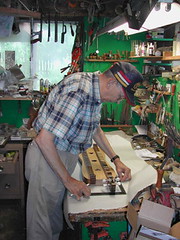
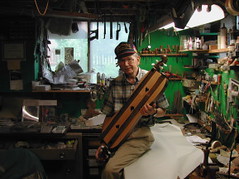
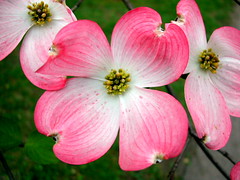

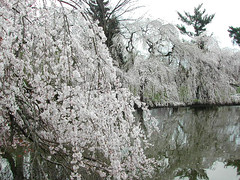

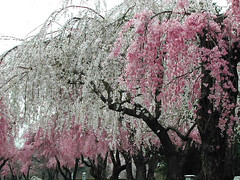


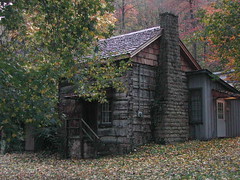
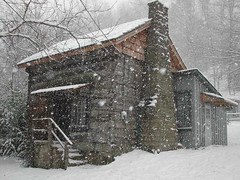
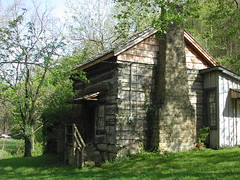
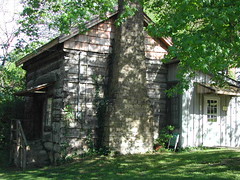
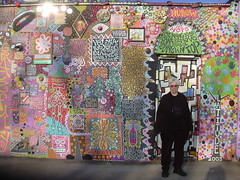
 Ever the intrepid writer and thinker, Mick has opened the portals to an ideal world in which knowledge is everywhere and all are welcome to partake.
Ever the intrepid writer and thinker, Mick has opened the portals to an ideal world in which knowledge is everywhere and all are welcome to partake.
